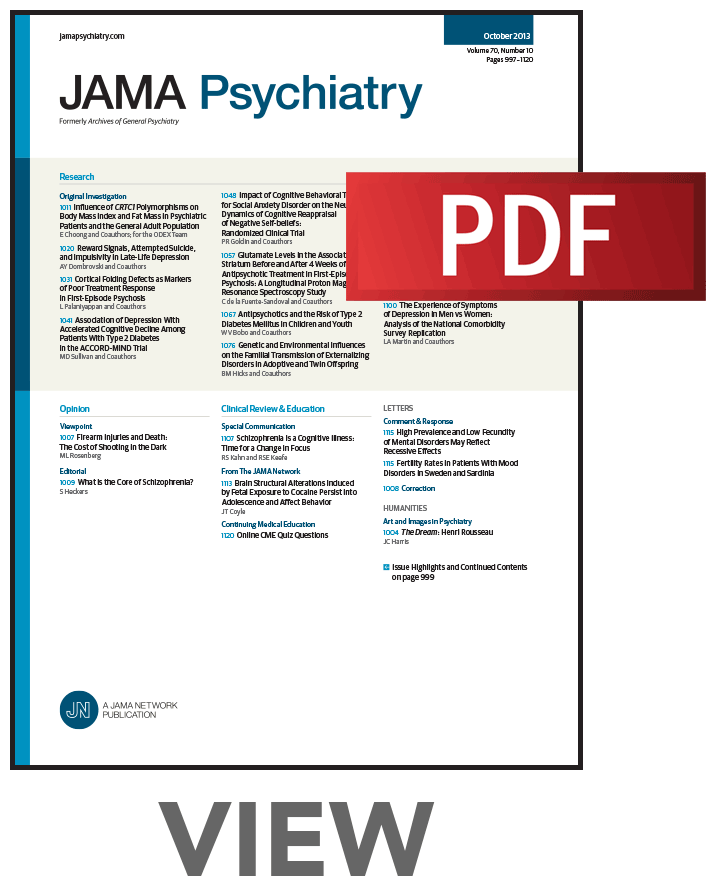Health Outcomes of Discontinuing Antipsychotics After Hospitalization in Older Adults.
IF 17.1
1区 医学
Q1 PSYCHIATRY
引用次数: 0
Abstract
Importance Among hospitalized older adults, prolonged use of antipsychotic medications (APMs) following hospital discharge may increase the risk of APM-associated adverse events. There are limited data on whether early discontinuation of APMs is associated with reduced adverse clinical outcomes compared with APM continuation after discharge. Objective To compare clinical outcomes between discontinuation vs continuation of APMs initiated to manage hospitalization-related delirium. Design, Setting, and Participants This population-based cohort study examining nationwide US Medicare claims data from July 1, 2013, through December 31, 2018, and data from a large deidentified US commercial health care database (Optum CDM) from July 1, 2004, through May 31, 2024, included adults aged 65 years and older without psychiatric disorders or previous use of APMs who filled an APM prescription within 30 days of hospital discharge. Using incidence density sampling, APM discontinuers (gap ≥45 days) were matched with continuers based on the type of APM prescribed, the time since their first APM prescription, and whether they had been admitted to intensive care units prior to the first APM prescription. Data analysis was performed from July 12, 2024, to December 25, 2024. Exposure Discontinuation vs continuation of APMs. Main Outcomes and Measures Propensity score matching was applied to adjust for 162 covariates. Study outcomes included rehospitalization, specific rehospitalization reasons, and all-cause mortality. Hazard ratios (HRs) were estimated using the Cox proportional hazards model; estimates from the 2 databases were further pooled using the fixed-effects meta-analysis model. Results A total of 13 712 propensity score-matched pairs were included, for an overall sample of 27 424 adults (discontinuers: mean [SD] age, 81.86 [7.26] years; 7400 [54.0%] female; continuers: mean [SD] age, 81.86 [7.27] years; 7360 [53.7%] female). During the median (IQR) follow-up of 180 (87-180) days, APM discontinuation vs continuation was associated with significantly lower risks of rehospitalization (HR, 0.89 [95% CI, 0.85-0.94]), inpatient delirium (HR, 0.87 [95% CI, 0.79-0.96]), fall-related emergency department visits or hospitalizations (HR, 0.77 [95% CI, 0.67-0.90]), hospitalization with urinary tract infection (HR, 0.79 [95% CI, 0.66-0.94]), and all-cause mortality (HR, 0.77 [95% CI, 0.69-0.86]). There was no statistical difference in the risks of pneumonia (HR, 0.88 [95% CI, 0.73-1.06]) or stroke (HR, 1.22 [95% CI, 0.97-1.53]) between discontinuers and continuers. Subgroups by dementia status, type and dose of APM prescribed, and duration of APM exposure showed consistent results. Conclusions and Relevance Based on 2 nationwide US cohorts including older adults without psychiatric disorders, APM discontinuation was associated with reduced risks of all-cause rehospitalization and mortality, suggesting the importance of minimizing the duration of APM use after acute hospitalization.老年人住院后停用抗精神病药物的健康结果
在住院的老年人中,出院后长期使用抗精神病药物(APMs)可能会增加APMs相关不良事件的风险。与出院后继续使用APM相比,早期停用APM是否与减少不良临床结果相关的数据有限。目的比较停药与继续用药治疗住院相关性谵妄的临床效果。设计、环境和参与者这项基于人群的队列研究检查了2013年7月1日至2018年12月31日美国全国医疗保险索赔数据,以及2004年7月1日至2024年5月31日美国大型未识别商业医疗保健数据库(Optum CDM)的数据,包括65岁及以上无精神疾病或以前使用过APM的成年人,他们在出院后30天内填写了APM处方。采用发生率密度抽样的方法,将停药者(间隔≥45天)与继续用药者根据所开APM的类型、首次开APM后的时间以及首次开APM前是否入住重症监护病房进行匹配。数据分析时间为2024年7月12日至2024年12月25日。停用与继续使用APMs。主要结局和测量方法采用倾向评分匹配对162个协变量进行调整。研究结果包括再住院、特殊再住院原因和全因死亡率。采用Cox比例风险模型估算风险比(hr);使用固定效应元分析模型进一步汇总两个数据库的估计值。结果共纳入13 712对倾向评分匹配对,总样本为27 424名成人(间断者:平均[SD]年龄81.86[7.26]岁;女性7400人[54.0%];随访者:平均[SD]年龄81.86[7.27]岁;7360例(53.7%)。在180(87-180)天的中位(IQR)随访期间,停药与继续用药的再住院风险(HR, 0.89 [95% CI, 0.85-0.94])、住院患者谵妄(HR, 0.87 [95% CI, 0.79-0.96])、跌倒相关急诊就诊或住院(HR, 0.77 [95% CI, 0.67-0.90])、尿路感染住院(HR, 0.79 [95% CI, 0.66-0.94])和全因死亡率(HR, 0.77 [95% CI, 0.69-0.86])显著降低。停药组和继续服药组发生肺炎(HR, 0.88 [95% CI, 0.73-1.06])和中风(HR, 1.22 [95% CI, 0.97-1.53])的风险无统计学差异。按痴呆状态、APM的类型和剂量以及APM暴露时间划分的亚组显示出一致的结果。结论和相关性基于美国2个全国性队列,包括无精神疾病的老年人,停用APM与全因再住院和死亡风险降低相关,提示急性住院后缩短APM使用时间的重要性。
本文章由计算机程序翻译,如有差异,请以英文原文为准。
求助全文
约1分钟内获得全文
求助全文
来源期刊

JAMA Psychiatry
PSYCHIATRY-
CiteScore
30.60
自引率
1.90%
发文量
233
期刊介绍:
JAMA Psychiatry is a global, peer-reviewed journal catering to clinicians, scholars, and research scientists in psychiatry, mental health, behavioral science, and related fields. The Archives of Neurology & Psychiatry originated in 1919, splitting into two journals in 1959: Archives of Neurology and Archives of General Psychiatry. In 2013, these evolved into JAMA Neurology and JAMA Psychiatry, respectively. JAMA Psychiatry is affiliated with the JAMA Network, a group of peer-reviewed medical and specialty publications.
 求助内容:
求助内容: 应助结果提醒方式:
应助结果提醒方式:


